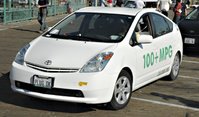California's electricity - Phasing out coal
 In its headlong rush to take the front line in the fight against Global Warming (California's AB32) the California Energy Commission has approved regulations that limit the purchase of electricity from power plants that fail to meet strict greenhouse gas emissions standards. That has to be considered bad news for neighboring states which have built coal plant facilities specifically to service the insatiable electricity demands of Californians. According to the Los Angeles Times, 47% of the electricity purchased by the Los Angeles Department of Water and Power comes from giant coal-fired plants in Arizona and Utah.
In its headlong rush to take the front line in the fight against Global Warming (California's AB32) the California Energy Commission has approved regulations that limit the purchase of electricity from power plants that fail to meet strict greenhouse gas emissions standards. That has to be considered bad news for neighboring states which have built coal plant facilities specifically to service the insatiable electricity demands of Californians. According to the Los Angeles Times, 47% of the electricity purchased by the Los Angeles Department of Water and Power comes from giant coal-fired plants in Arizona and Utah.
The benchmark number that new contracts must meet is 1,100 pounds of carbon dioxide (CO2) per megawatt hour. A 2000 study by the U.S. Department of Energy, Carbon Dioxide Emissions from the Generation of Electric Power in the United States, shows that the standard means electricity coming from plants that are cleaner than the average natural gas plants of 1999 (1,321 versus coal's whopping average of 2,095 pounds of CO2 per megawatt hour).
There is no discrimination between carbon positive (fossil fuels) vs. carbon neutral sources of energy. There should be because co-firing carbon neutral biostock could ease the blow to existing coal plant operations.
It is important to note that California periodically suffers brown-outs during the summer months and was the victim of the deregulation electricity nightmare of 2000 and 2001. As Wikipedia recounts the tail:
The California electricity crisis (also known as the Western Energy Crisis) of 2000 and 2001 resulted from the gaming of a partially deregulated California energy system by energy companies such as Enron and Reliant Energy. The energy crisis was characterized by a combination of extremely high prices and rolling blackouts. Price instability and spikes lasted from May 2000 to September 2001. Rolling blackouts began in June 2000 and recurred several times in the following 12 months.
That is not to suggest that current legislation is a "result of gaming". However, it is important that compensating power generators be contracted relatively quickly with a clearcut guarantees that the current benchmark does not suffer downward creep that would raise the risks for investors. As we learned in 2001, it is the public that will suffer the possible consequences and pay the ultimate tab of mis-steps of our energy decisionmakers.
Here is a reprint of the press release made May 23, 2007 by the California Energy Commission...
----------------
New Regulations Restrict Purchase of Electricity From Power Plants That Exceed Greenhouse Gas Emission Limits
New Performance Standard to Regulate Power Plants
The California Energy Commission today approved regulations that limit the purchase of electricity from power plants that fail to meet strict greenhouse gas emissions standards. New regulations, as part of SB 1368 (Perata), prohibit the state's publicly owned utilities from entering into long-term financial commitments with plants that exceed 1,100 pounds of carbon dioxide (CO2) per megawatt hour.
"Working with the Legislature, the Governor has demonstrated a clear vision with this first-in-the-nation legislation to reduce emissions," said Energy Commission Chairman Jackalyne Pfannenstiel. "His bold leadership is helping to reduce California's carbon footprint by ensuring a clean supply of electricity," continued Pfannenstiel.
The implementation of SB 1368 is part of the Energy Commission's further implementation of AB 32 (Nunez), a landmark bill signed by Governor Arnold Schwarzenegger that calls for California to reduce emissions of carbon dioxide and other gases by 25 percent by 2020.
To reduce greenhouse gas emissions, SB 1368 directed the Energy Commission, in collaboration with the California Public Utilities Commission (CPUC) and the California Air Resources Board, to establish a greenhouse gas emission performance standard for power plants.
This standard was reached by evaluating existing combined-cycle natural gas baseload power plants across the west and is the same CO2 measurement approved by the CPUC.
Created by the Legislature in 1974, the California Energy Commission is the state's primary energy policy and planning agency. The Energy Commission has five major responsibilities: forecasting future energy needs and keeping historical energy data; licensing thermal power plants 50 megawatts or larger; promoting energy efficiency through appliance and building standards; developing energy technologies and supporting renewable energy; and planning for and directing state response to energy emergency.
technorati BIOoutput, emissions, electricity, legislation


















